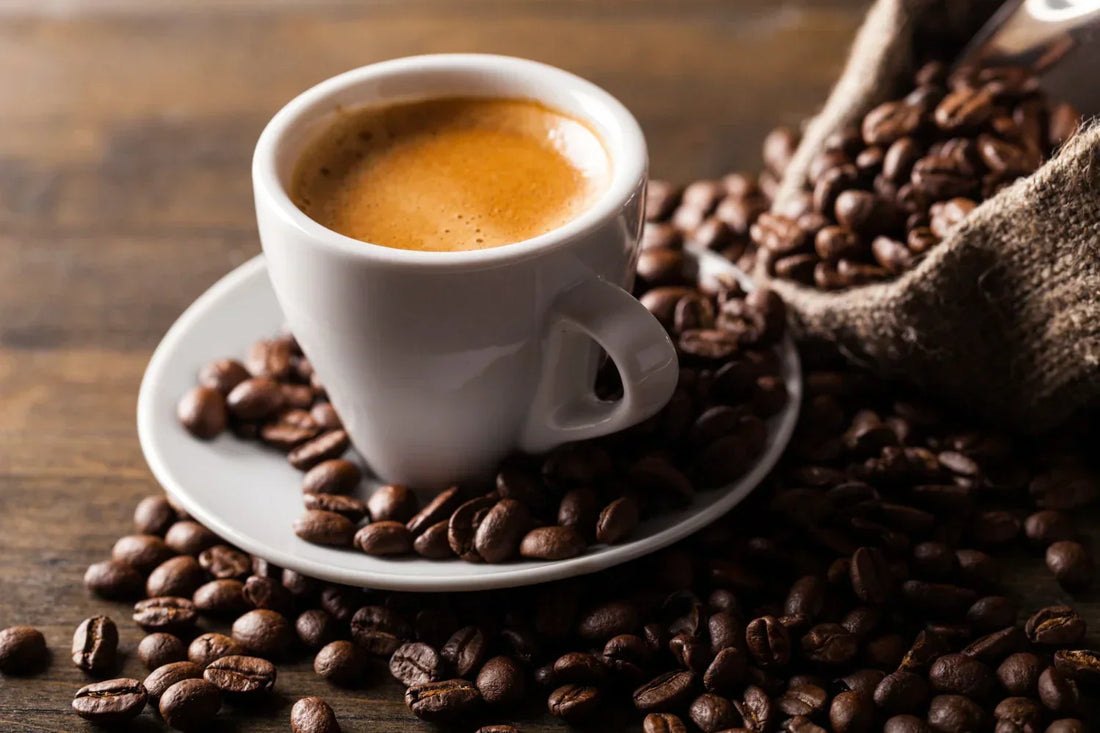
The Best Non-Oily Coffee Beans for Espresso
Share
Did you know that the United States imports over $4 billion worth of coffee per year? That’s a lot of beans, and they come from places all over the world such as Colombia, Kenya, and Vietnam.
As a coffee drinker, you likely already understand how big of a role coffee plays in your life and the lives of millions of others around you. However, that doesn’t make it any easier to choose the right beans for your morning espresso.
After all, the best non-oily espresso beans might be hard to come by. You want a bean that is strong and flavorful, but you don't want one that is so oily that it leaves a residue on your cup or your espresso machine
If you’re interested in learning how to distinguish the difference between great espresso beans and something sub-par, then let’s walk you through some of the best non-oily espresso beans.
What Are Espresso Coffee Beans?
Okay, so let’s start off with the basics. If you’re new to brewing espresso then you might be wondering what the difference between espresso beans and regular coffee beans is.
Espresso coffee beans are coffee beans that have been roasted and ground specifically for espresso. Unlike other types of coffee, espresso is made using a very small amount of water that is forced through the grounds at high pressure.
This results in a strong, concentrated shot of coffee with a thick crema on top. Espresso is often served as the base for other drinks like cappuccinos and lattes, but it can also be enjoyed on its own.
Because of the unique brewing method, espresso coffee beans have a much bolder flavor than other types of coffee. They are also typically darker in color and have a slightly oily surface.
Yes, this means that if you're looking to make a delicious espresso at home, you’ll need to ensure you’re purchasing espresso coffee beans.
What Causes Oily Coffee Beans?
We've all seen it before…the oily sheen on the surface of our precious coffee beans.
But what causes this? Is it something to do with the way they're roasted? Or is it just a natural characteristic of certain types of beans? The answer, it turns out, is a bit of both.
Some coffee beans are naturally more oily than others. This is due to the variety of the bean, as well as its growing conditions. For example, Robusta beans typically have more oil than Arabica beans. Additionally, coffee beans that are grown in hot, humid climates tend to be more oily than those grown in cooler climates.
When it comes to roasting, darker roasts also tend to bring out more oil in the beans. This is because, during the roasting process, the oils are forced to the surface of the bean. So if you're looking for a less oily cup of coffee, you might want to stick with a lighter roast.
However, you don’t have to go all the way to a light roast.
Both Cinquestelle by Caffe' Cartapani and Espresso Casa are medium roasts (the latter being an Italian espresso), for example, and have the perfect oil content to ensure that you won’t be damaging your espresso machine (more on that below).
At the end of the day, there's no one-size-fits-all answer when it comes to oily coffee beans. It all depends on the type of bean and how it's been roasted.
Why Oily Espresso Beans Are Bad for Your Espresso Machine
Currently, good in-home espresso machines range in price from about $400 to $1,000. That’s quite an expensive investment that you’re going to want to protect. One way to do that is to avoid using oily coffee beans when you brew espresso.
Why? How do they damage your espresso machine?
First, the oil can build up on the heating elements, causing them to overheat and eventually fail. Additionally, oily beans can clog the filters and tubing of the machine, leading to decreased performance and eventually a complete breakdown.
And, before they even reach the inner workings of the espresso machine itself, they can actually damage your grinder, too.
The oil from the beans gets stuck to the grinder in the same way that it does the other parts of your machine. Over time, this damages the machine and also leads to a rancid buildup of gunk that, well, doesn't taste great.
Ultimately, when you use oily espresso beans, it affects everything. From the grinder to the hoppers, brew unit screens, and portafilters, it clogs everything up.
Likewise, the oil can transfer from the beans to the cup, resulting in an unpleasant taste and an oily residue on the cup.
For these reasons, it is important to use only fresh, non-oily espresso beans in order to avoid damaging your machine.
The Best Non-Oily Espresso Beans
Now that you understand what causes high-oil espresso beans and why it’s important to look for beans with lower oil content to avoid damaging your espresso machine, it’s time to dive into some of the best beans for a quality brew!
Want our answer to the question “What is the best non-oily espresso bean?” We suggest a medium roast! Yep, we know this is contradictory to what most people think. Espresso beans are supposed to be dark, right?
They don’t have to be. Just look at all of the evidence we’ve given you above.
Ultimately, a medium roast allows you to taste the distinct flavor profiles of the specific type of coffee bean you’re using for your expresso. Darker roasts tend to squeeze out all of the individual notes, resulting in a more uniform, less dynamic taste.
As well, a medium roast is able to retain some of the bean’s acidity. This means that if you’re purchasing expensive Italian coffee and want to preserve the unique flavors in each bean, a medium roast is your best bet.
In fact, Bean Poet supports this claim, noting that "Traditionally, the dark roast was used to mask the taste of substandard coffee beans."
Outside of a medium roast, though, how do you ensure you’re getting the right beans for a non-oily cup of espresso?
Arabica vs. Robusta Beans for Espresso
Arabica beans are grown at high altitudes and have a sweeter, softer flavor. They also contain less caffeine than Robusta beans.
Robusta beans, on the other hand, are generally used for espresso blends and regular coffee blends. The beans do have higher caffeine content. This leads them to have a bit of a bitter taste.
However, when roasted correctly, Robusta beans offer coffee lovers a full-bodied and delicious taste.
Arabica beans are typically used in specialty coffees, while Robusta beans are used in espresso blends and coffees with added flavors.
When it comes to espresso, you’re going to want to opt for quality, and that doesn't necessarily come down to Arabica vs. Robusta.
In fact, most high-quality brands use both Robusta and Arabica and tend to roast them at levels suitable for espresso drinks.
So blends are okay for espresso coffee beans too? Absolutely!
In fact, Caffè Cartapani Espresso Casa is a high-quality blend of Robusta and Arabica beans from farms in South America and Asia.
The Best Country to Get Espresso Beans From
As mentioned above, the best beans for espresso are going to be either Arabica beans or a high-quality blend of both Robusta and Arabica beans. And, you can find those in many countries.
From Ethiopia to Brazil and all the way over to Vietnam, many countries produce widely-varying types of beans grown at different altitudes and climates. Where the key lies in selecting the best non-oily espresso bean is in the brand and how they roast it!
In this case, there’s nothing quite like Italian espresso. After all, Italians have been perfecting the art of coffee-making for centuries, so you can be sure that your espresso will be made with skill and experience.
If you're looking for the best espresso beans in the world, there's no better place to look than Italy. More specifically, there’s no better place than Caffè Cartapani.
The Best Non-Oily Espresso Beans Brand
While we’re obviously a little bit biased, we’ve also taste-tested hundreds of different espresso beans from all over the world. The winner? It’s always Caffè Cartapani, and that’s why we proudly import their beans into the US.
And, Caffè Cartapani is the best brand for espresso beans due to the way that they roast their coffee. The key to the full flavor and even tasting notes and profile lies in the fact that the Italian brand slowly roasts each coffee.
They use only the latest technology and systems to evenly control roasting time and temperature to obtain an impeccable result.
Then, once the coffee is slowly roasted, they automate the packaging process to ensure an espresso blend that is homogeneous with an aroma that is unmatched.
The result? Authentic Italian espresso that is neither too light nor too dark. And, a blend that is the best when it comes to high-quality, non-oil coffee beans for espresso.
How to Correctly Brew Espresso Beans
While you won’t be responsible for roasting your espresso beans, you will have to brew them! And, understanding how to brew the beans correctly can truly make or break your morning.
There are a few key things you need to keep in mind in order to make a perfect cup of espresso. First, start with freshly ground beans. This will ensure that your coffee is full of flavor and has the right consistency.
If you can, we suggest grinding your beans each morning. However, if you can’t, then grinding them weekly is fine too.
Next, use filtered water to avoid any unwanted flavors in your coffee. Filtered water helps to remove impurities that can give coffee an unwanted flavor.
Unfiltered water, on the other hand, can introduce minerals and other contaminants that can alter the taste of your coffee. If you're looking for the best possible flavor in your cup of morning espresso, using filtered water is a simple way to improve the taste.
Finally, be sure to use a quality espresso machine. This will help to extract all of the flavors from the beans and produce a rich, creamy cup of coffee. With these tips in mind, you should be able to brew a perfect cup of espresso each and every time.
Brewing Espresso With Caffè Cartapani
Looking for the best non-oily espresso beans? Caffè Cartapani offers undistinguishable quality and taste.
Whether you’re new to Italian espresso or are just finding your love for the European style and quality, Espresso Casa offers rich flavors with notes of chocolate and cream. Enjoy it as a straight shot every morning or as the base of an at-home cappuccino.
To enjoy Expresso Casa from Caffè Cartapani at home, view buying options on Amazon.
